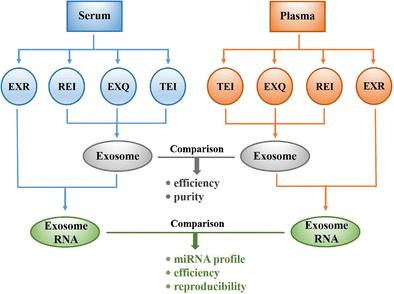Analytical and Bioanalytical Chemistry ( IF 4.3 ) Pub Date : 2018-04-18 , DOI: 10.1007/s00216-018-1052-4 Meng Ding , Cheng Wang , Xiaolan Lu , Cuiping Zhang , Zhen Zhou , Xi Chen , Chen-Yu Zhang , Ke Zen , Chunni Zhang
Circulating exosomal microRNAs (miRNAs) are valuable biomarker candidates; however, information on the characterization and mutual agreement of commercial kits for circulating exosomal miRNA profiling is scarce. Here, we analyzed the advantages and weaknesses of four commonly used commercial kits for exosomal miRNA profiling and their application to the sample of serum and/or plasma, respectively. NanoSight and Western blotting were conducted to evaluate the efficiency and purity of the isolated exosomes. In our conditions, the size distribution of the isolated particles was appropriate (40–150 nm), and ExoQuick™ Exosome Precipitation Solution (EXQ) generated a relatively high yield of exosomes. Nevertheless, albumin impurity was ubiquitous for all the four kits, and Total Exosome Isolation for serum or plasma (TEI) yielded a relatively pure isolation. We further performed Illumina sequencing combined with RT-qPCR to determine the ability of these kits for miRNA profiling. There was significant correlation of the exosomal miRNA profile and specific miRNAs between kits, but with differences depending on methods. exoRNeasy Serum/Plasma Midi Kit (EXR) and EXQ performed better in the specific exosomal miRNAs recovery. Intraassay CVs for specific miRNA measurement were 0.88–3.82, 1.19–3.77, 0–2.70, and 1.23–9.11% for EXR, TEI, EXQ, and RIBO™ Exosome Isolation Reagent (REI), respectively. In each kit, serum yielded a higher abundance of exosomes and exosomal miRNAs than plasma, yet with more albumin impurity. In conclusion, our data provide some valuable guidance for the methodology of disease biomarker identification of circulation exosomal miRNAs.

Circulating exosomal microRNAs (miRNAs) are valuable biomarker candidates; however, information on the characterization and mutual agreement of commercial kits for circulating exosomal miRNA profiling is scarce. In this study, we compared four commonly used commercially available kits for exosomal miRNAsextraction and analyzed the advantages and weaknesses of each kit and their application to the sample ofserum and/or plasma
中文翻译:

用于循环外泌体microRNA分析的商业外泌体分离试剂盒的比较
循环外体微RNA(miRNA)是有价值的生物标志物候选物;然而,关于用于循环外泌体miRNA谱分析的商业试剂盒的表征和相互同意的信息很少。在这里,我们分析了四种常用的用于外泌体miRNA谱分析的商业试剂盒的优缺点,以及它们分别在血清和/或血浆样品中的应用。进行了NanoSight和Western印迹以评估分离的外泌体的效率和纯度。在我们的条件下,分离出的颗粒的大小分布合适(40–150 nm),并且ExoQuick™外泌体沉淀溶液(EXQ)产生了相对较高的外泌体产量。尽管如此,所有四种试剂盒中普遍存在白蛋白杂质,血清或血浆(TEI)的总外泌体分离产生了相对纯净的分离。我们进一步进行了Illumina测序和RT-qPCR的结合,以确定这些试剂盒进行miRNA分析的能力。试剂盒之间,外泌体miRNA谱与特异性miRNA有显着相关性,但根据方法的不同而存在差异。exoRNeasy血清/血浆Midi试剂盒(EXR)和EXQ在特定的外泌体miRNA回收中表现更好。对于EXR,TEI,EXQ和RIBO™外来体分离试剂(REI),用于特定miRNA测量的测定内CV分别为0.88–3.82、1.19–3.77、0–2.70和1.23–9.11%。在每种试剂盒中,血清产生的外泌体和外泌体miRNA的含量均高于血浆,但白蛋白杂质含量更高。综上所述,

循环外体微RNA(miRNA)是有价值的生物标志物候选物;然而,关于用于循环外泌体miRNA谱分析的商业试剂盒的表征和相互同意的信息很少。在这项研究中,我们比较了四种常用的用于外泌体miRNA提取的试剂盒,并分析了每种试剂盒的优缺点以及它们在血清和/或血浆样品中的应用



























 京公网安备 11010802027423号
京公网安备 11010802027423号